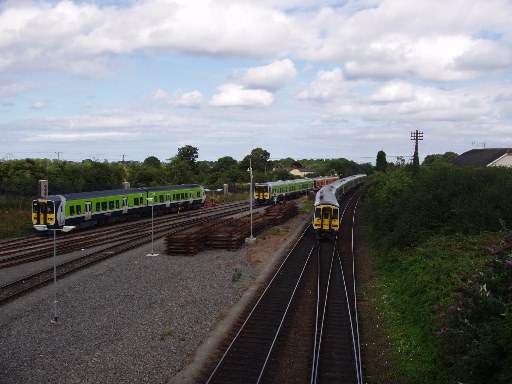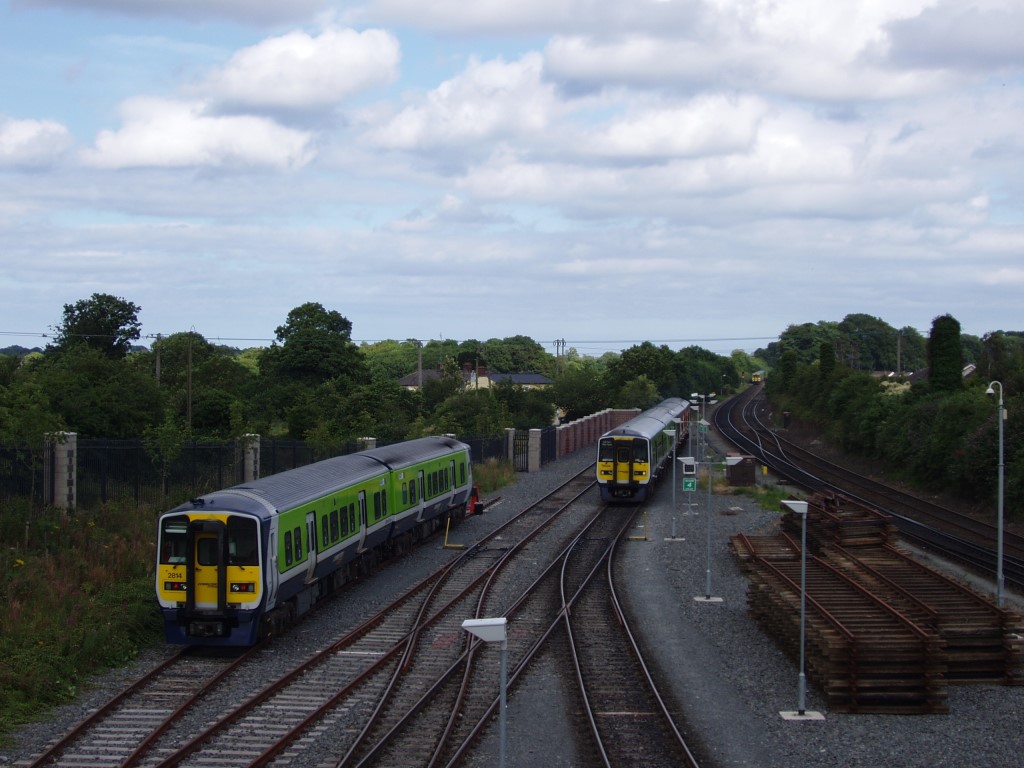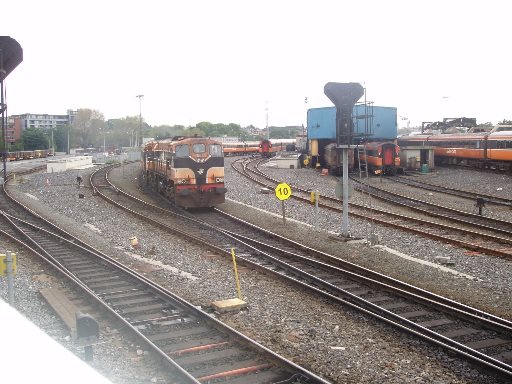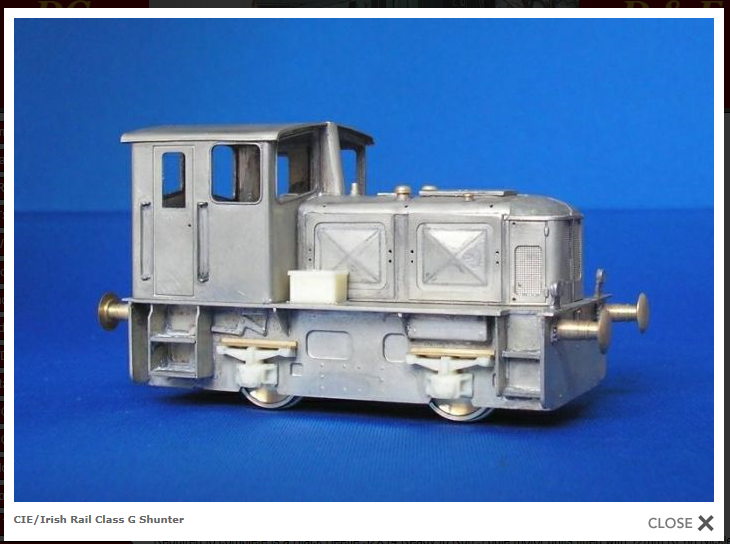-
Posts
4,741 -
Joined
-
Last visited
-
Days Won
119
Content Type
Profiles
Forums
Resource Library
Events
Gallery
Blogs
Store
Community Map
Posts posted by Mayner
-
-
Was there a physical connection between the power cars to enable MU e.g thru the unpowered coaches. They were usually separated within the formation from each other, no different from a PP service though, I guess.
If any one has a photo of these continental gangways I would be interested to see how they appear
The MU controls were electro-pneumatic with intermediate coaches wired to run with the railcars. The BUT railcars and coaches had the same type of rubber gangways as used in mainland Europe were draft roof and would have required less maintenance than the type of gangway used in Ireland
As David said the 600 Class was limited to a maximum of two power cars, the BUTs and CIE 2600 cars 4 power cars. Why CIE never re-wired its barely run in 600s to bring them in line with its own 2600 fleet is on of lifes little mysteries
-
 1
1
-
-
I think the railcars were assembled in Dundalk from parts supplied by BUT. The 700s seem to have been introduced before the single ended 900s, the original GNR publicity photo is of the BUTs is of an Enterprise with 4 700 class power cars and 2 non powered trailer cars.
I think the original intention was to design a train that could be divided to run to different destinations. This is supported by the double ended 700 Class and continental style corridor connections.
The GNR managed to operate a fast Belfast-Enniskillen service for a few weeks before the Irish North Closed in 1957 with a 700 class by dividing a Belfast-Derry (Foyle Rd) BUT railcar set at Omagh.
After the break-up of the GNR CIE seems to have used its BUTs on Westland Row-Rosslare services in preference to its own AEC cars which were less powerful.
There was talk of CIE selling its last serviceable BUT set to NIR during the 70s, CIE overhauled a set of BUT railcars during a loco shortage but the unit was stored in Dundalk paint shop and never went back into service.
-
 1
1
-
 1
1
-
-
Thank you for your replies. It's great to know some n gauge models can be converted to look like Irish locos with some work. 3D printing I'm sure will help hugely with this as well.
I'm not sure if I want to model steam era or diesel yet. I like modern locos, but steam could look nicer passing through a countryside setting.
Peter
A reasonable selection of Irish 3d printed N gauge models are available from Shapeways
http://www.shapeways.com/shops/valvedesign?s=0#more-products. I think the diesel locos are designed to run on Lifelike N Gauge chassis. The main challenge is in achieving a reasonable surface finish on 3d printed material
-
The garden railway is taking on more and more of a DRGW/RGS theme with structures and rolling stock
Finally added a water tower to the main station after 8 years! Picked up a Piko water tower on e-bay nicely weathered.
RGS Motor #4 on the passenger/mail run. This is a brass model produced by Accucraft about 8 years ago converted to on board battery 24GH RC control.
I need to sort out some 1:20.5 figures.
-
 1
1
-
-
We rode the California Zephyr from Denver to San Fransisco the crossing of the Rockies and Sierra Nevada are both in daytime.
-
Isn't it strange that trains were limited to 30, in the fledgling H&S-obsessed world! Twenty five years earlier I remember 35 and 40 - and loose coupled at that - as commonplace.
I suppose you could argue that the 30 wagon limit was an elf and safety thing as it kept a fully laden train within the 560 ton load limit for a loose coupled train on the WRC and hopefully allowed the driver and guard to keep control and prevent a run away.
Taking a load limit of 780 tons on the majority of main line routes a beet train could theoretically load up to 40 12 ton opens with a gross weight of 18 tons.
I wonder whether laden beet trains from midlands and east loaded to the 780 ton 40 wagon limit for the journey over the MGWR line and excess tonnage left at Athenry for collection by a Gort-Tuam special or an overload goods.
Overloads were common enough on lines with heavy goods traffic and severe load/weight restrictions. An overload would be run for just 1-2 wagons once the regular goods was fully loaded. In steam days overloads were common over the Limerick-Sligo line as the heaviest loco allowed was a J15
-
Just had a look at the CIE 1980 WTT Loose coupled goods trains hauled by a 001, 181, 141 or pair of GMs were allowed to load to a maximum of 560 tons or 45 vehicles including a 30 ton brake van between Ennis & Claremorris, a 121 or 201 was allowed 10 tons less
Laden trains would have been restricted to 30 opens plus van, trains could be loaded up to 780 tons or a max of 66 wagons on most of the main lines.
CIE carried a lot of goods and mineral traffic at the time, ore traffic probably peaked around 1980 with Zinc from Tara & Silvermines, Byrytes from Silvermines and Dolomite and Magnesite in an out of Ballinacourty heavy traffic all years rather than a seasonal traffic over 3 months.
Tuam used to process beet from Dundalk, Navan, Enfield and Kerry in addition to stations on the Ennis-Athenry line
-
Full report (316 pages, but the first 40-odd give you the overall idea) https://www.nationaltransport.ie/wp-content/uploads/2016/11/2016_Rail_Review_Report_Complete_Online.pdf
The report is a lot more optimistic about the future of rail than similar reports in the 70s & 80s and is pro-active in identifying IEs medium term funding requirements.
Proposals to close Nenagh Branch & Limerick Junction-Waterford line seems to have been used as part of CIEs/IEs negotiating strategy to secure government funding for the railways for the best part of 40 years.
It will be interesting to see if the Government implements the more positive recommendations, or the branches are sacrificed to secure some additional funding for the main lines.
The same sort of thing went on in the 70s the Government would cap CIEs subsidy and at the same time refuse fare and rate increases to cover national pay awards and increased fuel and material costs during a periods of rampant inflation.
CIE & IE managers and staff became very skilled at doing more with less until the system started to fall apart in the early 1990s
-
Came across these while reading the thread on Cement Bubbles.
Specially for Junction Mad Claremorris-Westport Liner beautiful time capsule
Back when CIE ran really long goods trains and Tuam was a busy place
-
Even more uncomfortable reading - http://www.bbc.co.uk/news/uk-scotland-glasgow-west-37975937 ...
Strikingly similar to the underlying cause of the Malahide Viaduct collapse. The engineers that had knowledge of the structure had either retired or had been made redundant when Network Rail was re-structured.
-
The change from jointed track on wooden sleepers to continuous welded rail on concrete sleepers (CWR) followed much the same pattern in Ireland to the UK.
The Irish main line companies experimented with composite concrete and steel sleepers as an alternative to timber during WW11 or the Emergency, concrete sleepers were widely used with jointed track on CIE, the GNR & UTA from the mid-1950s.
Main lines were gradually re-laid in CWR from the early 1970s onward this work was completed in the mid-2000s leaving a few secondary lines with jointed track on timber or concrete sleepers.
The Downpatrick line is laid in jointed track with bullhead rail on concrete sleepers salvaged from NIR, many of the concrete sleepers used by CIE in the 50s & 60s ended up in the coastal defence system on the South Eastern line between Greystones and Newcastle Co Wicklow.
Most yards were laid in jointed flatbottom track on timber sleepers, while concrete sleepered track and points are used at Drogheda Railcar Depot, the Eastwall Road marshalling yard was re-laid with jointed track on timber sleepers salvaged from the Shelton Abbey Marshalling Yard around the same time.
Once in use it become difficult to tell the difference from a distance because of weathering with brake dust and general grime.
Some photos from Heuston & Drogheda about 10-11 years ago
Main line crossover Drogheda
Concrete sleepered track and standard points railcar depot
Recently laid curved points on timber sleepers CWR on running line and sidings Heuston 2005
-
The old Q Kits Metrovicks were a real diamond in the rough, but got the basics correct and could be built into a convincing model. The less said about the whitemetal version of the A the better.
Kieran does your loco have brass gears or rubber band final drive? I found the Bull Ant with the brass gears extremely noisey and ordered on with rubber band drive for comparison but never got round to using it.
-
Its an ambitious plan, its appears to have a lot in common with John Allens original 6X4 Gorre & Daphetid https://en.wikipedia.org/wiki/Gorre_%26_Daphetid. with the looped 8 main line station at the front edge and a branch line and industry at the back
I would definitely recommend an operating well perhaps 2'X4' in the centre, this would help to separate the Arklow and Shelton Abbey scenes. Operation is likely to be restricted by the short length of the passing loop at Arklow and the lack of another loop or hidden staging on the main line.
A double track main line might be a better option to keep two reasonably long trains running on the main line and a third at Shelton Abbey.
With the space available the loose coupled era with wooden and corrugated opens and a C Class pilot shuttling wagons between the marshalling yard and the factory might be a better option otherwise fertiliser trains are likely to be restricted to 2-3 bogie wagons
-
Love it Iain Rice's trademark outside slip assembled in OO rather than EM or P4 using Peco components.
-
I usually run the railway when I am gardening/mowing the lawn, only problem was yesterday was a soft day, but the forecast for next week is for more wet weather.
The K27 will haul a heavy train all day long with its new speed controller (decoder) but will still slip on greasy rail, got to fit sound

Send for a Helper Loco
Climbing the Divide!
Usually the caboose was cut in behind the helper, though these sort cabooses were designed for pusher service
The main reason for using the helper was to put the train to bed before it got too wet/too dark!
-
A railway works was not the healthiest of places to work, all traditional railway work had a history of industrial deafness, lung diseases and work place cancers which were basically accepted as part of life up to modern OSH legislation in the 70s & 80s
Rail is one of the safest means of travel, but the railways by a large had and to a certain extent still have a poor worker safety record and culture
-
Always looked forward to Tony Koesters Train of Thought column in the Model Railroader and took out a regular subscription when I was working in Athlone about 20 years ago. His "Coal Fork Extension" and a visit to West Virginia lead me to a brief dalliance with an Appalacian coal and logging branch around the time Bachmann brought out their HO Shay, which kind of morphed into On30 and 1:20.3 n the garden though the railroad has move West to Colorado. I am fortunate to have the space that is rare in Ireland and can run round and round or operate a way freight picking up and dropping off cars at a number of towns if the fancy takes me.
-
Last few weeks have mainly been maintenance and repairs on the large scale, fitting a new RCS power controller/receiver to the K27 now capable of contiuously hauling 12 very heavy Accucraft freight cars around the garden railway, transferring the old controller receiver to RGS Motor No4 & machining a new bogie pivot bolt for the C16 after the existing bolt dropped out in the dark and I could not find it and making a start bonding the rail joints on a section of track re-laid two years ago!
I made a start on fitting an interior to the CIE buffet car, which did not work out as planned as the re-skinned Dapol coach is narrower than a scale width model and has thick plastic sides.
The small flotilla of Tin Vans have just about finished their trip through the paint shops, next stage is to fit couplings, fuel tanks and final finishing and fix down the roofs.
The green and golden brown are laquers mixed at the local paint shop very hard wearing and resistant to solvent.
Next job is to finish a batch of MGWR vans I started nearly 3 years ago
-
The G617 is a lovely little job. It might be worth checking if the roof profile of the g601 is correct - from the photos it looks a little flat? Its front grille is a bit small too.
The photos were intended to show the nature of the Worsley Works chassis and provide a comparison between the two batches of locos.
The G601 was built in plasticard several years before the Worsley Works G Class came on the scene.
If I ever get round to it I would use the Worsley Works engine housing, frames and Bufferbeams as a basis for a G601 with a new running board and cab, rather than try and improve the existing model.
When it will ever be done is another question of a backlog of repairs and unfinished kits that will take years to complete, the call of large scale rtr is very strong by comparison.
-

1 piece frames and horizontal frame spacers
The Worsley Works set of parts is supplied with a simple fold up chassis and pair of nylon gears. The chassis is designed for 21mm gauge & one of the vertical frame spacers appears to be designed as a motor mount.

I originally motorised the loco using a Black Beetle motor bogie, which I have since 'borrowed" to motorise a SSM Wickham trolley.
Whenever I get round to it I will look at the option of fitting a layshaft and 2:1 spur gearing to the Worsley Works chassis, or simply order a 21mm gauge 28:1 Black Beetle from Steam Era Models.
Its simple enough to build a G611 using the Worsley Works parts, steps, marker lights, possibly exhaust housing and other detail parts can be assembled from brass strip of tube. I started to build a G601 out of plasticard but never got round to forming the engine access panels, this loco was powered by a Tenshodo Spud totally unsuitable for a small shunting loco.



There I still quite a bit of work to complete G617 to an acceptable standard, better to make a fresh start on G601
-




I spent this evening running trains and taking photos. The second photo shows Cork fiddle yard.
The photo of the VW Combi van under the viaduct takes me back of have a photo somewhere of my nearly new Rover 214SI parked under Stradally Viaduct during a weekend gricing the remains of the WDLR from Fermoy to Waterford.
-
New Zealanders still talk about Munster and Thomand Park like it was yesterday. The reaction at work today that it was that it was better to go down to Ireland than Australia or South Africa or France. Hopefully we will go for the Grand Slam in the 6 Nations

-
Great video, its interesting how rapidly 1970s state of the art Connolly CTC panel became obsolete while there is relatively little change in civil and mechanical engineering practice.
From a heath and safety perspective I would have more issues with CIEs workshop and laboratory practice than the staff snatchers. Workers were exposed to significant risks in the workshop and the laboratory footage, there was no risk to public safety while mechanical exchange was in use at Enfield and Maynooth the stations were closed and the signal man is in his cabin.
-
From what i remember the Worley one comes with castings for the axleboxes/springs.The rounded nose is no problem i just used about four thicknesses of plasticard laminated together,the trick is to use alternate black and whits plastic which makes it easier to see how the compound curve is shapeing up(works well on railcar roofs as well).Its a good kit and pretty easy to do.Andy.
I think the DC Kits G Class may be a better option than the Worsley Works or Silver Fox models. The master for the DC Kits loco were prepared by Mike Edge and has a higher level of detail and a better motor bogie than the Silver Fox model. Although more expensive the Black Beetle with a 27:1 gear ratio would be a much better option for a shunting loco than a Spud or standard 15:1 Blackbeetle
I built a model of G Class using the Worsley Works parts several years ago. I had to carry out quite major modifications to the cab due to a design error in the kit. Basically the position of the cab doors and windows were transposed on the one piece cab fret and it was necessary to cut out the cab sides with a piercing saw then swap them around after 1st assembling the cab.
Worsley Works appear to have modified the artwork in response to the problem. The witness marks to the cuts are visible on the photo of Mike Edge’s Worsley G but not on Patrick Quinns loco.
http://www.worsleyworks.co.uk/Image-Pages/Image_4mm_Deutz.htm
.png.c363cdf5c3fb7955cd92a55eb6dbbae0.png)

.jpg.3bb694cce8af89530afac49beea9fdec.jpg)
.jpg.ab536137ae1f1ab9cbb0f194d59e1e00.jpg)
.jpg.0861dc3d9bbf21ca1d63c8dfe84cccde.jpg)



.jpg.b57fe6d44595b29236782f18ae91b569.jpg)
.jpg.6f11df3ffe65cf8cd6f9811207255fa6.jpg)
.jpg.ceb455e342219f89995fb92fc3fbf0c6.jpg)
.jpg.c6a8726e55b08446839b3614a041ea3c.jpg)

.jpg.c89fbb5acc0f1a9d288d372338406eeb.jpg)
.jpg.5c55839a6df5d9dc2c49fbc6605555d4.jpg)
.jpg.6b5b075342ce36fc120247fc03a7b15d.jpg)
.jpg.2d6ac0fa7c3ee485883728e59f0473dd.jpg)
.jpg.957b0c6924d05a0aeb2e5e8bb190f495.jpg)

Freight train stranded by North Canterbury Earthwork
in Weblinks
Posted · Edited by Mayner
A southbound freight on the Main Line North MLN) ended up stranded between two slips when the quake struck just after Midnight on 13th amazingly no one was injured and the train appears to be undamaged.
http://www.stuff.co.nz/national/nz-earthquake/86698393/kiwirail-waiting-to-recover-goods-from-train-in-no-mans-land-near-kaikoura
The main issue seems to be keeping the looters at bay until the road is re-opened which could be a matter of months or years. The railway and road run from the ferry port of Picton to Christchurch. Train ferries are used to transport wagons between Wellington & Picton and most of the rail traffic is through freight between the Christchurch and the North Islands.